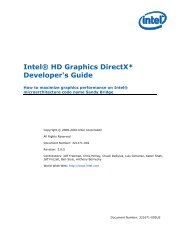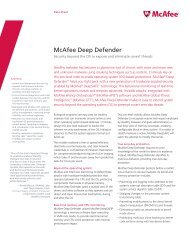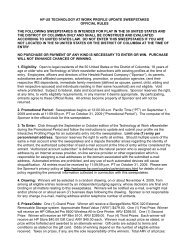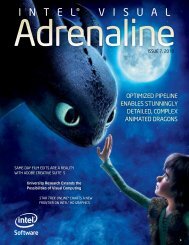Intel ® Visual
Intel ® Visual
Intel ® Visual
You also want an ePaper? Increase the reach of your titles
YUMPU automatically turns print PDFs into web optimized ePapers that Google loves.
india’s animation industry<br />
To explore the importance of technology at a pair<br />
of leading animation studios, <strong>Visual</strong> Adrenaline<br />
reached out to executives at Crest Studios, a local<br />
production house, and Rhythm & Hues, an<br />
international producer with developers in India.<br />
They discussed their technology infrastructure<br />
and the importance of <strong>Intel</strong>-based systems, and<br />
demonstrated their enthusiasm for future<br />
product development.<br />
Cutting Down<br />
Compute-Years<br />
Starting in 1987, Rhythm & Hues transitioned<br />
from creating simple flying logos to more<br />
challenging animation. Today it creates Academy<br />
Award-winning VFX. Gautham Krishnamurti, CTO<br />
at Rhythm & Hues, described how his company<br />
grew into a powerhouse in the global animation<br />
industry. “In 1999, we acquired VIFX from 20th<br />
Century Fox, and in 2001 we opened our first<br />
international studio in Mumbai, India. In 2007,<br />
we expanded to Hyderabad, India, followed by<br />
Kuala Lumpur, Malaysia, in 2009. We are currently<br />
opening a facility in Vancouver, British Columbia.”<br />
The company currently employs over 1,400<br />
workers in three countries. Recent and upcoming<br />
projects include Mr. Popper’s Penguins (Fox),<br />
X-Men: First Class (Fox), Life of Pi (Fox), Everybody<br />
Loves Whales (Universal), Alvin and the<br />
Chipmunks: Chip-Wrecked (Fox), Moneyball (Sony),<br />
and Snow White and the Huntsman (Universal).<br />
Gauth explained that significant changes have<br />
recently occurred in his industry. The VFX<br />
requirements have become significantly more<br />
challenging, while the production schedules have<br />
grown tighter. “It took us 2,000 compute-years<br />
to render the imagery seen in HOP,” an Easterthemed<br />
movie released in early 2011 that was<br />
produced by Universal Studios and Illumination<br />
Entertainment. “Prior to that, our most intensive<br />
job only took 400 compute-years. We had to<br />
scale our infrastructure eight-fold to handle that<br />
show’s demands,” he said.<br />
E.B., the star of the movie HOP.<br />
machines with four to eight gigabytes of RAM.<br />
Today, they range from quad-core to dual six-core<br />
machines, with 24 to 64 GB of RAM.”<br />
Gauth reserves the most powerful workstations<br />
to handle the most compute intensive tasks.<br />
“Some VFX artists have access to 24-core <strong>Intel</strong><br />
processors with 64 GB of RAM,” he said. “Some<br />
simulations take up to five days to compute.”<br />
Rendering imagery is his most expensive compute<br />
operation, but with shrewd investments, their<br />
latest batch of rendering servers, which rely on<br />
<strong>Intel</strong><strong>®</strong> Core i7 processors, has met the challenge.<br />
While technology issues have been solved with<br />
hardware investments, hiring artists to run those<br />
machines has been difficult. “Finding suitable<br />
talent is a global problem,” according to Gauth.<br />
“All of our facilities have the same issue—having<br />
to train a lot of the artists—so we created<br />
apprentice programs for the various disciplines.”<br />
Hooray for Bollywood!<br />
While speaking with AK Madhavan, CEO of Crest<br />
Animation Studios Ltd., his passion and enthusiasm<br />
for the Indian animation industry was contagious.<br />
In 1999, Crest delved into long format animation<br />
in the computer-graphics animation space. “I think<br />
we have established credibility and a comfort level<br />
among several ‘big boys,’ like Universal, Sony, and<br />
Lions Gate, and we are doing some great work<br />
for Disney and DreamWorks. So the industry has<br />
grown fairly well in the outsourcing model,” he said.<br />
“I believe that in the television space, India delivers<br />
much higher quality than other Asian outsourcing<br />
facilities. We’ve moved from work for hire to<br />
co-owning intellectual properties and building our<br />
own ideas.”<br />
The key behind Crest’s growth has been continual<br />
investment in technology, according to Madhavan.<br />
“Over the years we made many mistakes; we<br />
The growing power of multi-core CPUs with<br />
hyper-threading have made Rhythm & Hues<br />
rethink its programming paradigm. “Our compute<br />
infrastructure includes workstations<br />
and render nodes, and our latest hardware uses<br />
<strong>Intel</strong><strong>®</strong> processors. A few years ago, most of our<br />
compute infrastructure comprised dual-core<br />
Source: FICCI-KPMG Indian Media and<br />
Entertainment Industry Report 2011.<br />
intel visual adrenaline no. 10, 2011 37













